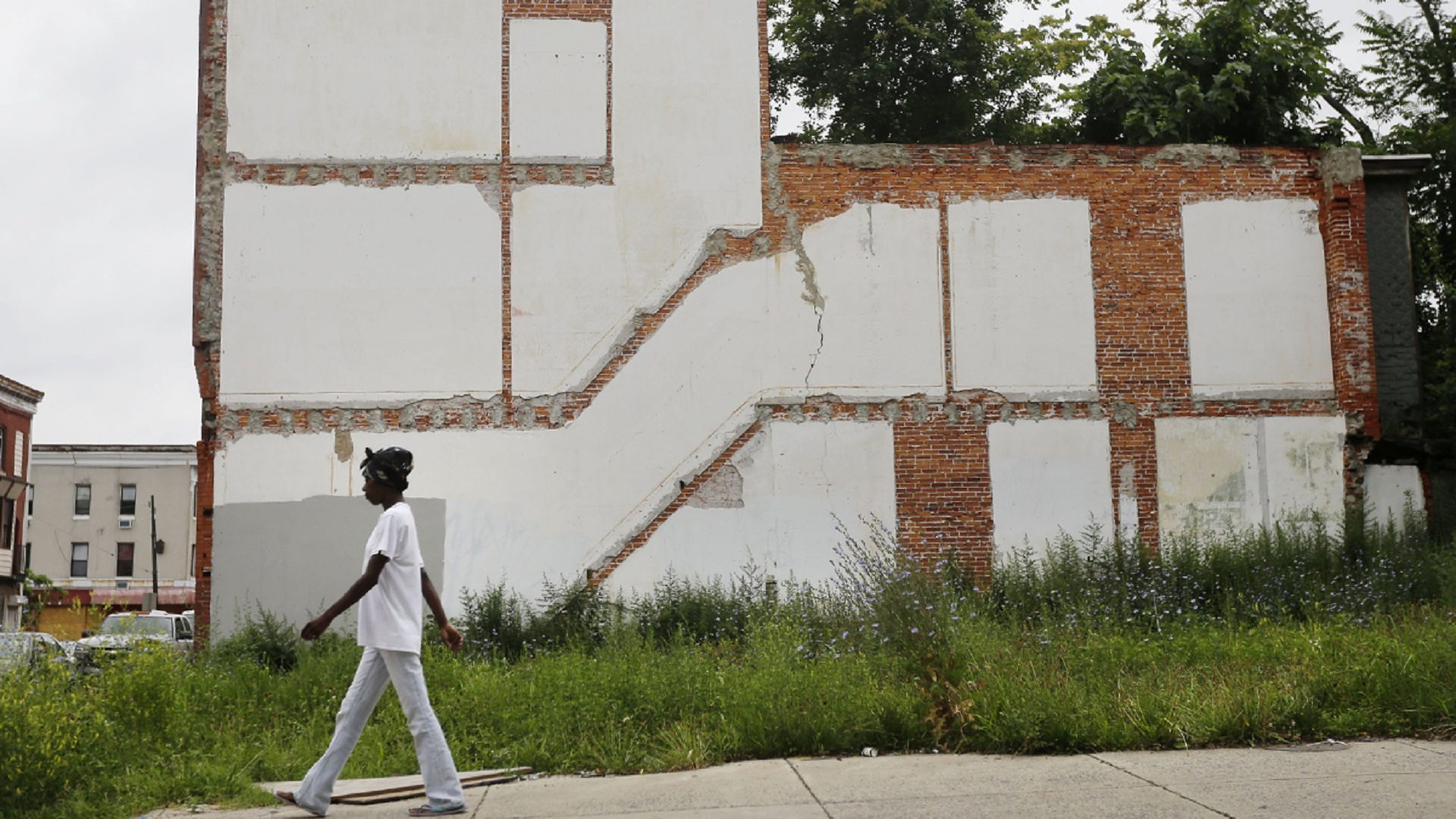
A woman walks through a blighted neighborhood in Philadelphia, Pa.
Matt Rourke / Associated Press

A woman walks through a blighted neighborhood in Philadelphia, Pa.
Matt Rourke / Associated Press

Matt Rourke / Associated Press
A woman walks through a blighted neighborhood in Philadelphia, Pa.
(Pittsburgh) — Thousands of vacant and abandoned properties across Pennsylvania harm neighbors, hamstring local budgets, decrease property values, and make it harder to attract people and businesses that can help counteract the long spiral of deindustrialization. That’s what speakers told members of the House Urban Affairs Committee on Thursday during a hearing held in Brackenridge, about 20 miles northeast of Pittsburgh.
A 2013 study suggests that blight reduces the value of nearby homes or businesses by 15 percent, said Lance Chimka, director of Allegheny County Economic Development.
“That’s like $1.2 billion in value … which represents about $5 million in annual tax [revenue], just for the county,” he said.
Fewer tax dollars means less money to spend on services — and higher tax rates for remaining residents, which can lead to further exodus. It’s a cycle that state legislators have taken seriously for years, and they’ve passed a slate of bills to help address it. Those range from the creation of land banks to allowing counties to assess new fees to fund demolition.
Legislators asked those who testified what new tools they needed, or how to refine existing laws to better address blight.
Chimka said the state’s conservatorship law, which allows a “competent entity” to petition the courts to take over property, needs legislative attention. He said there’s been an increased interest in using the law to take over property near hot City of Pittsburgh neighborhoods.
He recommended refining the eligibility requirements and offering better education to judges. That would “get the tool back on track to its legislative intent of eliminating blight” rather than “gassing rapidly appreciating housing markets,” he said.
Greg Miller, the new director of the Pittsburgh Land Bank, later suggested that the state require a statement of community support before land can be transferred via conservatorship, and that land banks be allowed to use the law to secure property.
Jason Rigone directs both Westmoreland County Planning and Community Development and the Westmoreland County Industrial Development Corporation. He said that while vacant properties most often seem like a burden, they could become a resource. In order for that to happen, however, municipalities need to approach blight differently.
“We tend to focus on demolition as the primary and correct response,” he said, but “there is a need to address blight through preservation and building stabilization.”
There may not be a market for vacant buildings right now, Rigone said, but there could be later on. And putting on a roof to prevent deterioration has the potential to save money while propping open a door to the future. Many downtowns across the state have iconic, historic buildings, but they’ve deteriorated to the point where no private investor will sink money in to save them, he lamented. And without support for preservation, the problem will continue to snowball.
“There really aren’t sufficient resources to address this,” Rigone said.
In a statement, the Housing Alliance of Pennsylvania commended the committee for its interest in tackling blight.
“The physical, economic, and emotional costs of blight are real and are felt by residents, businesses, and communities in every region of Pennsylvania,” said Phyllis Chamberlain, executive director of the Pennsylvania Housing Alliance. “But while the presence of blight can have significant negative economic impacts, property remediation and redevelopment can have even greater positive economic impacts.”
Joe Hughes told the committee that to understand blight requires understanding what started it, and cited the collapse of manufacturing in the 1970s and 1980s.
“Jobs leave, people leave,” said Hughes, director of government relations for the International Union of Painters and Allied Trades, District Council 57.
He urged members to look at who and what the state invests in as officials try to remediate blight and kickstart the economy.
“We need to be concerned with who will be performing the work,” he said, adding that it should be union tradespeople.
Thursday’s hearing followed a tour of the region, in which members talked with business owners about the challenges they face, as well as their successes.
Rep. Carrie Lewis DelRosso, who represents parts of Allegheny and Westmoreland Counties, said this is a bipartisan effort.
“Blight and effective change doesn’t have a party attached to it,” she said.
The legislators talked about creation of a statewide registry of property owner contact information, because very often it’s difficult to hold landowners of vacant property accountable. And Rep. Tim Twardzik, who represents parts of Schuylkill County, said he is working on a bill that would assess a fee for vacant structures, revenue from which would go to local governments charged with code enforcement and demolition.

A collection of interviews, photos, and music videos, featuring local musicians who have stopped by the WITF performance studio to share a little discussion and sound. Produced by WITF’s Joe Ulrich.
The days of journalism’s one-way street of simply producing stories for the public have long been over. Now, it’s time to find better ways to interact with you and ensure we meet your high standards of what a credible media organization should be.